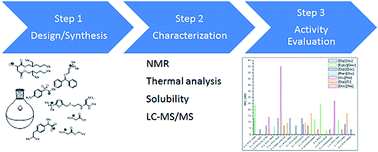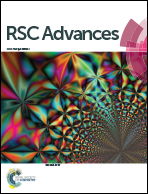Novel ibuprofenate- and docusate-based ionic liquids: emergence of antimicrobial activity†
Abstract
Six new ionic-liquid-based active pharmaceutical ingredients (IL-APIs) were prepared and their molecular structures characterized. Solubility and thermal properties was determined and compared with the salt precursors. Antifungal and antibacterial activities were also investigated. Some of the IL-APIs demonstrated limited water solubility and high thermal stability when compared with the salt precursor. The most interesting observation was that the combination of two pharmacologically active ingredients in an IL-API results in antifungal activity that was not present in the precursors. The antibacterial activities were very promising considering that one of them was active against Staphylococcus, which is a bacterium resistant to penicillin and methicillin. The study of the pharmacological properties of synthesized IL-APIs is essential for evaluating how a drug may interfere with the pharmacological properties of another drug, thus furnishing knowledge about the advantages or disadvantages related to the association of APIs.


 Please wait while we load your content...
Please wait while we load your content...